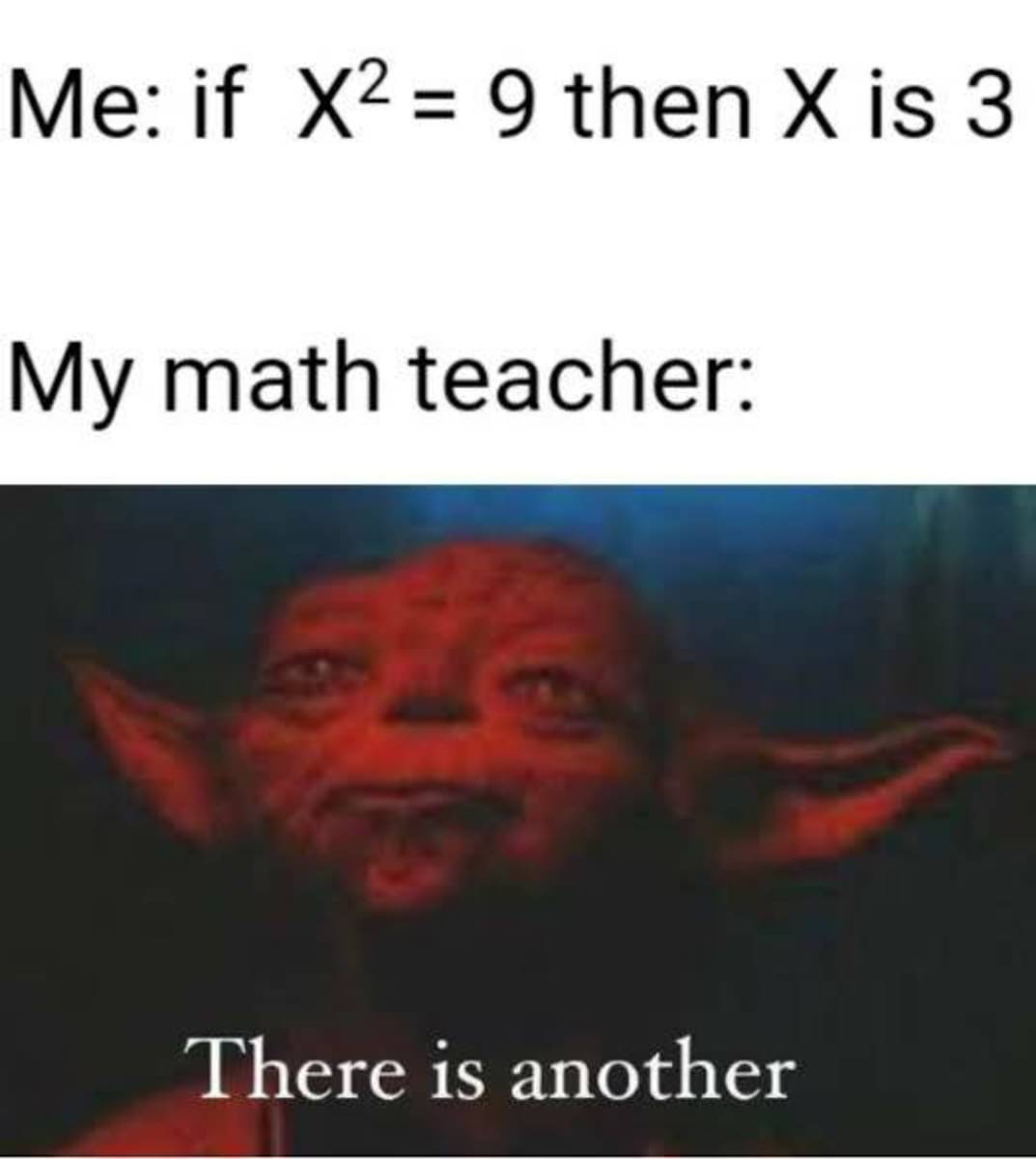-3 feels like cheating.
Science Memes
Welcome to c/science_memes @ Mander.xyz!
A place for majestic STEMLORD peacocking, as well as memes about the realities of working in a lab.

Rules
- Don't throw mud. Behave like an intellectual and remember the human.
- Keep it rooted (on topic).
- No spam.
- Infographics welcome, get schooled.
This is a science community. We use the Dawkins definition of meme.
Research Committee
Other Mander Communities
Science and Research
Biology and Life Sciences
- !abiogenesis@mander.xyz
- !animal-behavior@mander.xyz
- !anthropology@mander.xyz
- !arachnology@mander.xyz
- !balconygardening@slrpnk.net
- !biodiversity@mander.xyz
- !biology@mander.xyz
- !biophysics@mander.xyz
- !botany@mander.xyz
- !ecology@mander.xyz
- !entomology@mander.xyz
- !fermentation@mander.xyz
- !herpetology@mander.xyz
- !houseplants@mander.xyz
- !medicine@mander.xyz
- !microscopy@mander.xyz
- !mycology@mander.xyz
- !nudibranchs@mander.xyz
- !nutrition@mander.xyz
- !palaeoecology@mander.xyz
- !palaeontology@mander.xyz
- !photosynthesis@mander.xyz
- !plantid@mander.xyz
- !plants@mander.xyz
- !reptiles and amphibians@mander.xyz
Physical Sciences
- !astronomy@mander.xyz
- !chemistry@mander.xyz
- !earthscience@mander.xyz
- !geography@mander.xyz
- !geospatial@mander.xyz
- !nuclear@mander.xyz
- !physics@mander.xyz
- !quantum-computing@mander.xyz
- !spectroscopy@mander.xyz
Humanities and Social Sciences
Practical and Applied Sciences
- !exercise-and sports-science@mander.xyz
- !gardening@mander.xyz
- !self sufficiency@mander.xyz
- !soilscience@slrpnk.net
- !terrariums@mander.xyz
- !timelapse@mander.xyz
Memes
Miscellaneous
Eh, not really. It's been a while, but I'm pretty sure the rule in algebra when solving for a squared variable like this is to use ± for exactly that reason.
just wait for n-th roots of imaginary numbers :)
-3 id the hidden dark version character of the solution, like evil ryu or devil jin.
just a glimpse into my dark and twisted mind
Doesn’t x also equal -3?
Sqrt(9)
Uhm, actually 🤓☝️!
Afaik sqrt only returns positive numbers, but if you're searching for X you should do more logic, as both -3 and 3 squared is 9, but sqrt(9) is just 3.
If I'm wrong please correct me, caz I don't really know how to properly write this down in a proof, so I might be wrong here. :p
(ps: I fact checked with wolfram, but I still donno how to split the equation formally)
You're correct. The square root operator only returns the principal root (the positive one).
So if x^2 = 9 then x = ±√9 = ±3
That's why in something like the quadratic formula we all had to memorize in school its got a "plus or minus" in it: -b ± √...(etc)
Thanks, I haven't connected the dots to that (+-) sign and this problem.
x^2 = 9
<=>
|x| = sqrt(9)
would be correct. That way you get both 3 and -3 for x.
That's the way your math teacher would do it. So the correct version of the statement in the picture is: "if x^2 = 9 then abs(x) = 3"
Cool! Makes sense to me. Honestly, I've never done it this way, but it's so clean. Love it. Thanks.
Fund the sqrter!
Sqrt
hehe
Also math teacher...
"Show your work"
Middle school math memes
The number of solutions/roots is equal to the highest power x is raised to (there are other forms with different rules and this applies to R and C not higher order systems)
Some roots can be complex and some can be duplicates but when it comes to the real and complex roots, that rule generally holds.
I think you can make arbitrarily complicated roots if you move over to G^n^ which includes the R and C roots...
For example the grade 4 blade (3e1e2e3e4)^2 = 9 in G^4^
Complex roots are covered because the grade 2 blade (e1e2)^2 = -1 making it identical to i so G^n^ (n>=2) includes C.
G^n^ also includes all the scalars (grade 0 blades) so all the real roots are included.
G^n^ also includes all the vectors (grade 1 blades) so any vector with length 3 will square to 9 because u^2 = u dot u = |u|^2 where u is a vector.
All blades will square to a scalar but blades are not the only thing in G^n^ so things get weird with the multivectors(sums of different grades). Any blade with grade n%4 < 2 will square to a positive scalar and the other grades will square to a negative, with the abs of the scalar equal to the norm^2^ of the blade. Can pretty much just make as many roots as you want if you are willing to move into higher dimensional spaces and use a way cooler product.
You lost me at "arbitrarily complicated," sorry.
Lost me at "I think". I don't, apparently.
I don't think therefore I never was
I wish it was that easy! I stopped thinking and I'm still stuck here... Stupid Descartes
I thought this would be related to quaternions, octonions etc. but no, it's multivectors and wedge products. Very neat, I didn't know you could use them like that.
Oh no, you were right on the money. In G^2^ you have two basis vectors e1 and e2. The geometric product of vectors specifically is equivalent to uv = u dot v + u wedge v.. the dot returns a scalar, the wedge returns a bivector. When you have two vectors be orthonormal like the basis vectors, the dot goes to 0 and you are just left with u wedge v. So e1e2 returns a bivector with norm 1, its the only basis bivector for G^2^.
e1e2^2 = (e1e2)*(e1e2) = e1e2e1e2
A nice thing about the geometric product is its associative so you can rewrite as e1*(e2e1)*e2.. again that middle product is still just a wedge but the wedge product is anti commutative so e2e1 = -e1e2. Meaning you can rewrite the above as e1*(-e1e2)*e2 = -(e1e1)*(e2e2) = -(e1 dot e1)*(e2 dot e2) = -(1)*(1) = -1.. Thus e1e2 squares to -1 and is the same as i. And now you can think of the geometric product of two vectors as uv = u dot v + u wedge v = a + bi which is just a complex number.
In G^3^ you can do the same but now you have 3 basis vectors to work with, e1, e2, e3. Meaning you can construct 3 new basis bivectors e1e2, e2e3, e3e1. You can flip them to be e2e1, e3e2, e1e3 without any issues its just convention and then its the same as quaternions. They all square to -1 and e2e1*e3e2*e1e3 = -e2e1e2e3e1e3 = e2e1e2e1e3e3 = e2e1e2e1 = -1 which is the same as i,j,k of quaternions. So just like in G^2^ the bivectors + scalars form C you get the quaternions in G^3^. Both of them are just bivectors and they work the same way. Octonions and beyond can be made in higher dimensions. Geometric algebra is truly some cool shit.
Me, a statistician: "if chi-square equals 9 then chi equals 3... What??"
My teacher explained as sqrt(poop^2) = abs(poop). Yes, he wrote poop on the blackboard.
He should have drawn a pile of poop instead 💩 (preferably without a face)
Oh, I know this one! It's pi!
-3 = 3
Absolutely.
Adding 3 on both sides
3-3=3+3
0 = 6
1•0 = 6
1 = 6/0
1 = inf
Multiplying e^(iπ) on both sides,
e^(iπ) = - inf
iπ = ln|-inf|
π = ln|-inf| ÷ i
I know the math but I still feel like I'm out of the loop somehow?
There's nothing more to this than linking the star wars quote to the -3. That's it lol
(-3)^2 = 9 as well
